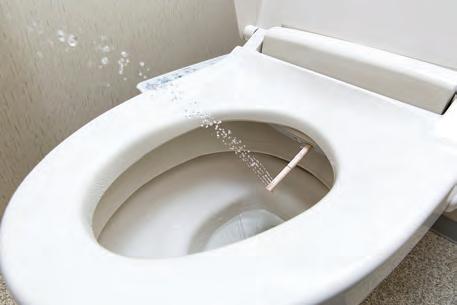
3 minute read
Bidet
From Page 12 service members’ first encounters with it were in a French brothel. That created an association with sex work.
The rest of the world, meanwhile, has embraced the concept, with the bidet evolving into myriad forms. I encountered the most basic version for the first time living in Southeast Asia: a handheld sprayer on the side of the toilet, similar to a sink faucet with a hose. The cheapest ones can cost just a few dollars.
But Japan ushered the French invention into the modern era. In 1980, Toto released the Washlet, integrating the bidet into the toilet seat itself. The underlying technology is simple. A small “wand,” or sprayer, extends from a housing under the seat to direct a precise stream of water that cleans the buttocks. When the water is turned off, the self-cleaning wand retracts behind a shield.
But things have gotten pretty extravagant from there. Today, Toto’s high-end models offer adjustable water temperature, air drying, a heated seat, bowl cleaning, personalized settings, a night light, remote controls, and even an automatic air deodorizer. More than 60 million of the devices have been sold around the world since 1980. Just not many in the United States.
Before the coronavirus pandemic, few Americans were interested in the fixture. “Bidets weren’t really gaining traction,” says Bill Strang, a Toto executive in the United States.
After March 2020’s toilet paper shortages, bidets climbed the e-commerce rankings, coming in just behind items such as disposable gloves, masks, hand sanitizer and toilet paper, reports Toto. “We sold out of our product in about four weeks in North America,” Strang says. Remote work has increased this momentum. As people spent more time in their home offices and bathrooms, they poured money into “refreshing” their homes – and behinds.

Start-ups such as Tushy have capitalized on this wave of interest, tailoring the often-complicated Japanese models to suit American tastes. Tushy makes several models starting at $69. The base model offers controls such as spray angle and intensity, as well as irreverent marketing: “Save Your A--, Save Your Money, Save the Planet.”
Founder Miki Agrawal says sales jumped fivefold during the pandemic. “It went from being something that seems weird, shameful and awkward to a boastful thing you show your friends,” says Agrawal, who says Tushy has more than 1.4 million customers.
Should you join these new converts? There are three reasons for taking the plunge: the environment, savings and performance.
The main one is to reduce clear-cutting mature forests. Every year, Americans flush the equivalent of millions of trees down the toilet. Much of this toilet paper comes from trees logged in Canada’s species-rich boreal forests, the vast landscape of plants and wetlands growing below the Arctic Circle. Nearly a quarter of the world’s last intact forest landscapes are in this region, says the Natural Resources Defense Council, storing about the same amount of carbon as three decades’ worth of fossil fuel emissions. By the time it reaches your bathroom, every roll of toilet paper has used up an estimated 1.5 pounds of wood and more than 6 gallons of water.
Bidets, meanwhile, require about one-eighth of a gallon per use, a fraction of the water required to make the amount of toilet paper needed for the same purpose. And since bidets tend to cut household consumption of TP by about 80%, they’re “a great alternative to using tissue products,” says the NRDC. It can also pay off in less than one year. A paper industry analysis by the research firm RISI found Americans consume about 24 rolls of TP per year on average – some estimates put it above 85 rolls. At today’s prices, the typical person would spend at least $30 annually on toilet paper. Since the cheapest bidet seats sell for about the same price, it’s an investment that can pay off in the same year. Savings for families are even larger.
In my experience, bidets just work better. You can never get as clean with toilet paper, or even wet wipes, as rinsing with water. “From a hygiene perspective, it just clearly makes sense,” says Evan Goldstein, an anal surgeon in New York City. Bidets also can reduce the risk of illness, from E. coli to urinary tract infections.

When I finally thought about it, the way we use toilet paper didn’t make much sense either.
We don’t shower by rubbing paper towels across our bodies. We don’t scrub our hands with dry scraps of tissue. Yet for the most demanding cleanup job in our daily lives, we employ a few thin sheets of paper.
Toilet paper is not going away. Nor should it, necessarily. But we have far better choices than standard TP available to us, from bamboo to recycled tissue, along with a bidet. It’s a purchase that sends a message about what options we want in the store. “Consumers have a lot of power here,” writes Shelley Vinyard, a boreal forests campaign director at the NRDC, who says companies are starting to make products without virgin tree fiber in response to demand. One day, we may come to see wiping our bums with extra-soft toilet paper from virgin forests as we do smoking cigarettes: mainly a good idea for the people who sell the products.








